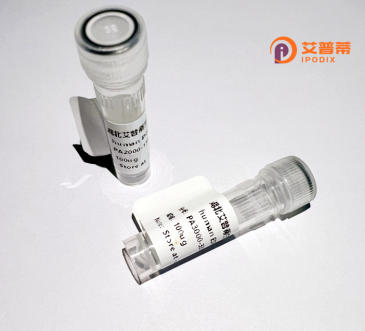
| 纯度 | >90%SDS-PAGE. |
| 种属 | Human |
| 靶点 | SCN1B |
| Uniprot No | Q07699 |
| 内毒素 | < 0.01EU/μg |
| 表达宿主 | E.coli |
| 表达区间 | 1-218 aa |
| 活性数据 | MGRLLALVVGAALVSSACGGCVEVDSETEAVYGMTFKILCISCKRRSETNAETFTEWTFRQKGTEEFVKILRYENEVLQLEEDERFEGRVVWNGSRGTKDLQDLSIFITNVTYNHSGDYECHVYRLLFFENYEHNTSVVKKIHIEVVDKANRDMASIVSEIMMYVLIVVLTIWLVAEMIYCYKKIAAATETAAQENASEYLAITSESKENCTGVQVAE |
| 分子量 | 49.61 kDa |
| 蛋白标签 | GST-tag at N-terminal |
| 缓冲液 | PBS, pH7.4, containing 0.01% SKL, 1mM DTT, 5% Trehalose and Proclin300. |
| 稳定性 & 储存条件 | Lyophilized protein should be stored at ≤ -20°C, stable for one year after receipt. Reconstituted protein solution can be stored at 2-8°C for 2-7 days. Aliquots of reconstituted samples are stable at ≤ -20°C for 3 months. |
| 复溶 | Always centrifuge tubes before opening.Do not mix by vortex or pipetting. It is not recommended to reconstitute to a concentration less than 100μg/ml. Dissolve the lyophilized protein in distilled water. Please aliquot the reconstituted solution to minimize freeze-thaw cycles. |
以下是关于重组人SCN1B蛋白的3篇参考文献及其摘要概括:
---
1. **文献名称**:*"SCN1B variants and their role in epilepsy: A genetic and functional analysis"*
**作者**:Patino GA, et al.
**摘要**:该研究通过基因测鉴发现SCN1B突变与癫痫综合征相关,并利用重组SCN1B蛋白体外实验证实突变体破坏了与Nav1.1钠通道亚基的相互作用,导致通道门控异常及细胞黏附功能受损。
---
2. **文献名称**:*"Structural insights into the β1 subunit of voltage-gated sodium channels"*
**作者**:Gilchrist J, et al.
**摘要**:通过X射线晶体学解析重组人SCN1B蛋白的胞外结构域,揭示其免疫球蛋白折叠模式及与Nav通道结合的关键位点,为研究通道调控机制提供结构基础。
---
3. **文献名称**:*"Regulation of cardiac sodium channel function by recombinant SCN1B protein"*
**作者**:Fahmi AI, et al.
**摘要**:在心肌细胞中表达重组SCN1B蛋白,发现其通过调控Nav1.5通道的失活过程影响动作电位,并证实SCN1B缺失导致心律失常易感性增加,强调其在心脏电生理中的关键作用。
---
如有其他特定研究方向需求,可进一步补充文献。
The human SCN1B protein, encoded by the SCN1B gene, is a regulatory subunit of voltage-gated sodium (Naᵥ) channels, which play critical roles in generating and propagating action potentials in excitable cells. SCN1B exists as two splice variants: β1 and β1B. The β1 subunit is a type I transmembrane protein with an extracellular immunoglobulin domain, while β1B is a secreted isoform lacking the transmembrane region. Both isoforms modulate Naᵥ channel gating kinetics, cell surface expression, and interactions with extracellular matrix proteins. SCN1B also participates in cell adhesion and neurite outgrowth through homophilic and heterophilic binding.
Mutations in SCN1B are linked to neurological and cardiac disorders. For instance, loss-of-function variants are associated with Dravet syndrome, generalized epilepsy with febrile seizures plus (GEFS+), and Brugada syndrome, highlighting its importance in neuronal and cardiac excitability. Recombinant SCN1B protein, typically produced in heterologous expression systems (e.g., CHO or HEK293 cells), serves as a tool to study Naᵥ channelopathies, screen therapeutic compounds, or investigate molecular mechanisms underlying these diseases. Its structural and functional conservation across species facilitates translational research. By reconstituting β1/β1B activity in vitro, recombinant SCN1B enables targeted exploration of sodium channel regulation and pathophysiological pathways, offering potential insights for precision medicine approaches in epilepsy and arrhythmias.
×